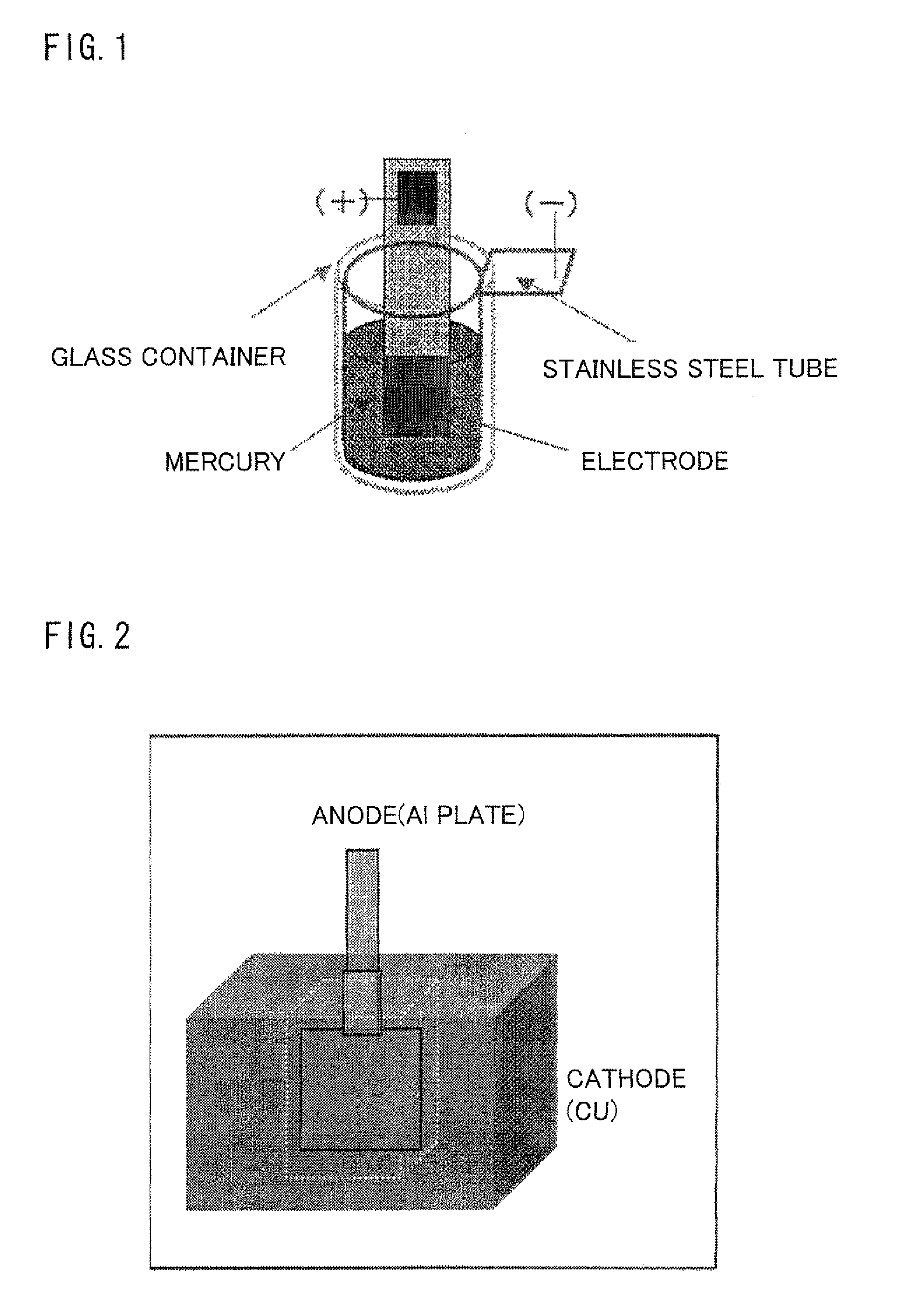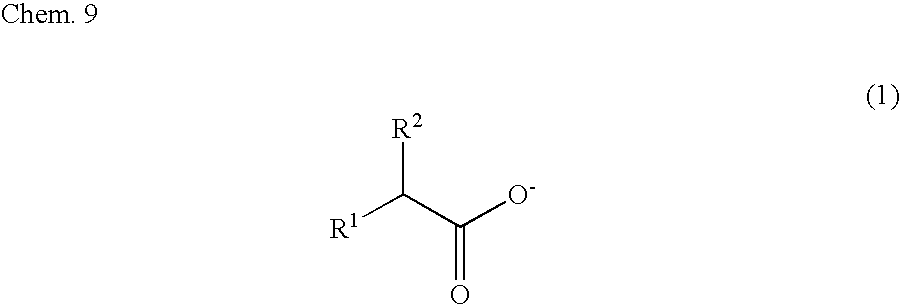Electrolyte composition and ionic liquid
a technology of electrolyte composition and ionic liquid, which is applied in the direction of capacitors, capacitor electrolytes/absorbents, conductive materials, etc., can solve the problems of not having ionic conductivity, the recovery (i.e. anodization) of the dielectric oxide film of the capacitor, and the inability to form a capacitor with a high withstand voltage, etc., to achieve excellent durability and anodization ability.
- Summary
- Abstract
- Description
- Claims
- Application Information
AI Technical Summary
Benefits of technology
Problems solved by technology
Method used
Image
Examples
example 1
[0099]A conductive polymer aluminum electrolytic capacitor was produced by forming a conductive polymer on an aluminum oxide film, which conductive polymer was formed by chemically polymerizing 3,4-ethylenedioxythiophene (hereinafter referred to as EDOT; manufactured by H.C. Starck-V TECH). Namely, an aluminum etched foil having an effective area of 10 mm×10 mm was immersed in 1% ammonium adipate aqueous solution, and a voltage applied was raised from 0 V to 45 V at a rate of 20 mV / sec. Subsequently, a constant voltage of 45 V was applied to the foil for 40 minutes, in order to form a dielectric film on a surface of the aluminum etched foil. Next, this foil was washed for 3 minutes with flowing deionized water, and then the foil was dried at 120° C. for 1 hour. A content of the aluminum etched foil in the liquid at this time was 25 μF. Next, EDOT and an ionic liquid [emim][LA] that constitutes ethylmethylimidazolium cation and lactic acid were blended so as to have a molar ratio of ...
examples 2 to 10
[0100]Capacitors were produced as similar to Example (Ex.) 1 except that the ionic liquids were changed to respective ionic liquids shown in Table 1, and characteristics of the obtained capacitors were evaluated. Results obtained are as shown in Table 1. By comparing these results and results of Comparative Examples (C. Ex.) 1 to 5 as shown in Table 3, it was confirmed that ionic liquids that had a carboxylic acid as its anion component attained a conductive polymer capacitor electrolyte that has excellent durability.
examples 11 to 13
[0101]Capacitors were produced as similar to Example 1 except that (i) the ionic liquid was [emim][LA], (ii) a respective salt shown in Table 1 was included so that a ratio of EDOT:[emim][LA]: salt was 1:0.25:0.25 (molar ratio), and (iii) a chemical polymerization composition to be used for electrolyte formation was prepared, and characteristics of the obtained capacitors were evaluated. Results obtained are as shown in Table 1.
[0102]
TABLE 1Impedance (Ω@10 kHz)AfterInitial650 hIn-(Ω@10(Ω@10creaseILssaltkHz)kHz)rate (%)Ex. 1[emim][LA]—1.44.3307.1Ex. 2[bmim][TFA]—1.13.8345.5Ex. 3[bmim][AcO]—1.55.0333.3Ex. 4[bmim][BA]—1.44.8342.9Ex. 5[bmim][MA]—1.23.4283.3Ex. 6[bmim][CA]—2.06.1305.0Ex. 7[bmim][PA]—1.65.5343.8Ex. 8[bmim][PB]—1.24.2350.0Ex. 9[bmim][PP]—1.23.9325.0Ex. 10[bmim][NA]—1.13.2290.9Ex. 11[emim][LA][emim][TsO]0.82.4300.0Ex. 12[emim][LA][emim][TFBSA]0.92.8306.7Ex. 13[emim][LA][emim][TFBSA]0.92.7303.3
PUM
 Login to View More
Login to View More Abstract
Description
Claims
Application Information
 Login to View More
Login to View More - R&D
- Intellectual Property
- Life Sciences
- Materials
- Tech Scout
- Unparalleled Data Quality
- Higher Quality Content
- 60% Fewer Hallucinations
Browse by: Latest US Patents, China's latest patents, Technical Efficacy Thesaurus, Application Domain, Technology Topic, Popular Technical Reports.
© 2025 PatSnap. All rights reserved.Legal|Privacy policy|Modern Slavery Act Transparency Statement|Sitemap|About US| Contact US: help@patsnap.com



